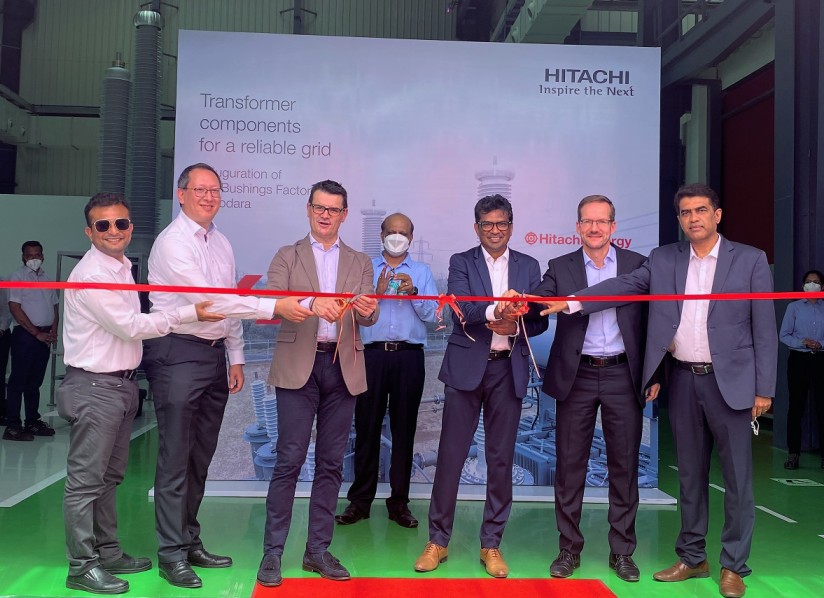We are committed to championing environmentally sustainable practices: Hitachi Energy India
- December 4, 2023
Hitachi Energy is a global technology leader that is advancing a sustainable energy future for all. In this exclusive interaction, we have Atul Pandit, Senior Vice President, Transformer, Hitachi Energy India, discussing the company’s transformer business. He asserts that Hitachi Energy India is making significant technological advancements that are in fact setting new benchmarks for the transformer industry. Pandit explains that for Hitachi Energy India, sustainability and localization are two important philosophies where the company is taking major strides. An interview by Venugopal Pillai.

We learn that in May last year, Hitachi Energy inaugurated its transformer components factory in Gujarat, primarily to produce RIP bushings up to 400kV rating. Has regular production started from this unit? What is the indicative capacity?
Hitachi Energy’s new transformer components factory in Gujarat commenced regular production soon after its inauguration. It marks a significant stride in meeting the escalating demand for Resin Impregnated Paper (RIP) bushings with a voltage rating of up to 400kV.
We received overwhelming support from our discerning customers. BHEL (Bharat Heavy Electricals Ltd), Bhopal, gave us a major contract in October 2022 of six 400kV RIP bushings. Our team delivered the order in a record time of five weeks as against a much longer lead time of 20-24 weeks when imported from overseas suppliers.
Currently we are producing 500 bushings in a year and have plans to increase the production capacity by another 20-30 per cent in future.
Please discuss the relative advantage of RIP bushings over conventional OIP bushings. Also, does Hitachi Energy supply RIP bushings to other transformer manufacturers also, or are they for captive consumption alone?
Resin Impregnated Paper (RIP) bushings stand out as a technologically advanced alternative to traditional oil-impregnated paper (OIP) bushings, offering a spectrum of advantages, starting from reduced risk of fire, lower weight, no oil supervision/oil conditioning, environment friendliness, etc. More importantly, RIP bushings can be energised immediately after installation. Furthermore, RIP bushings demand lower maintenance efforts and costs, contributing to overall operational efficiency and cost-effectiveness.
Hitachi Energy, as a trailblazer, not only incorporates RIP bushings into its own transformers, underscoring a commitment to cutting-edge technology, but also extends its influence by supplying these advanced components to other transformer manufacturers.
This collaborative approach not only benefits Hitachi Energy but also contributes to industry-wide advancements in technology and performance, fostering a collective drive towards higher standards in transformer manufacturing.
This dual strategy positions Hitachi Energy as a pivotal player not just in enhancing its own products but also in elevating industry benchmarks through the widespread adoption of RIP bushings.

What is Hitachi Energy’s view on producing “green” transformers — those equipped with natural/synthetic ester oil as opposed to conventional mineral oil?
The use of biodegradable insulation fluids with higher flash and fire points such as esters (natural and synthetic) helps to safeguard surrounding ecosystems from the risk of pollution and increase safety for people. Ester offers higher absorption capacity of free moisture in oil compared to mineral oil which helps increasing the life expectancy of the transformer insulation.
Also, it helps in reducing the carbon footprint, as it leaves minimal carbon footprint of 0.07 kg CO2 equivalent/kg produced, about ten times less than that of mineral oil.
At Hitachi Energy we are committed to championing environmentally sustainable practices in all spheres of our work. On the same line we have our eco-efficient transformer called EconiQ™ transformers. The EconiQ™ optimized transformer provides a reduction of over 21 per cent in the total carbon emissions across the lifecycle. The major contribution comes from lower emissions during operation associated with losses but also from the use of fossil-free electricity in manufacturing and the use of natural esters.
Hitachi Energy last year won a major order to supply 400kV transformers for renewable energy evacuation in Gujarat. What is the current status of this mega order? How do you see the prospects for EHV transformers, including 765kV, especially for RE evacuation?
 The winning of the major order of 400kV transformers for the evacuation of solar energy in Gujarat stands as a notable achievement, marking the company’s pivotal role in advancing renewable energy (RE) infrastructure. The order is in its advance stage of execution as per project timelines.
The winning of the major order of 400kV transformers for the evacuation of solar energy in Gujarat stands as a notable achievement, marking the company’s pivotal role in advancing renewable energy (RE) infrastructure. The order is in its advance stage of execution as per project timelines.
Looking forward, the prospects for extra high voltage (EHV) transformers, especially in the context of renewable energy evacuation, appear promising. The shift towards cleaner and sustainable energy sources is driving an escalating demand for EHV transformers to efficiently transmit power over long distances.
The Indian Ministry of Power has made clear roadmap to implement RE generation and to establish transmission system for integration of 500 GW RE generation by 2030. Considering this there would be major demand for transformers for evacuation of RE power, especially now at 400kV level, looking at size and scale of RE Parks. 765kV transformers are presently used for transmission of bulk power for long distance, which is a next step to the power evacuation from RE generation parks.
Apart from power transformers, Hitachi Energy, as we perceive, has been doing very well with other transformers, particularly traction transformers and dry transformers. Please discuss the prospects of dry transformers, and the growth drivers for the same.
 Hitachi Energy has demonstrated remarkable success in diversifying its transformer portfolio, notably excelling in the domain of dry transformers, with a specific focus on traction transformers. The burgeoning popularity of dry transformers can be ascribed to their distinct eco-friendly attributes and low-maintenance characteristics. These transformers have become increasingly sought after due to their capacity to minimize environmental impact and operational costs.
Hitachi Energy has demonstrated remarkable success in diversifying its transformer portfolio, notably excelling in the domain of dry transformers, with a specific focus on traction transformers. The burgeoning popularity of dry transformers can be ascribed to their distinct eco-friendly attributes and low-maintenance characteristics. These transformers have become increasingly sought after due to their capacity to minimize environmental impact and operational costs.
Traction transformers, a standout segment within this portfolio, assume a crucial role in advancing electrified transportation systems, aligning seamlessly with the global paradigm shift toward sustainable mobility.
The prospects for dry transformers, in general, are buoyed by the expanding adoption of electric vehicles (EVs) and a broader industry-wide trend favoring environmentally-conscious solutions. The dual benefit of reducing carbon footprints and meeting heightened sustainability standards positions dry transformers, including traction transformers, as pivotal components in driving the future of eco-friendly and efficient energy solutions.
Hitachi Energy’s success in this arena not only underscores its technological prowess but also reflects its adeptness at aligning with and driving the transformative trends in the evolving landscape of energy infrastructure.
What is the current extent of Hitachi Energy India’s localization with respect to transformers, especially for highly specialized transformers like HVDC converter transformers, etc.?
Hitachi Energy’s commitment to localizing its operations in India, particularly in transformer manufacturing, reflects a strategic alignment with the ‘Make in India’ for India and the world. The company has achieved significant localization, notably for highly specialized transformers like HVDC converter transformers.
Hitachi Energy India has over the years developed capability to design, manufacture, test and supply wide variety of transformers and shunt reactors locally at Vadodara and Savli facilities. Having built a solid foundation through its presence in India by supplying high-end products that meet today’s complex grid requirements.
The company has gained significant experience to add niche application products such as HVDC converter transformers which are highly complex to design, manufacture, process, and test.
We have done a commendable job in this segment by producing and commissioning a number of HVDC converter transformers like- first of its kind “multi-terminal 800kV HVDC projects — Northeast–Agra and Raigarh–Pugalur —for Power Grid Corporation of India Ltd.


